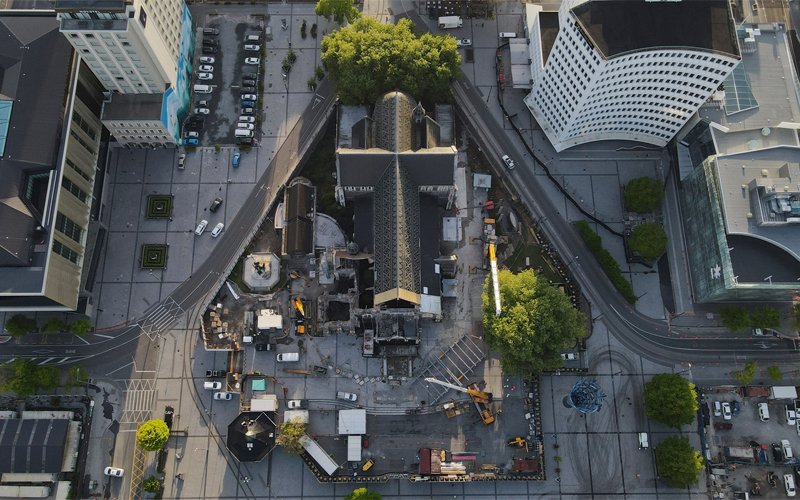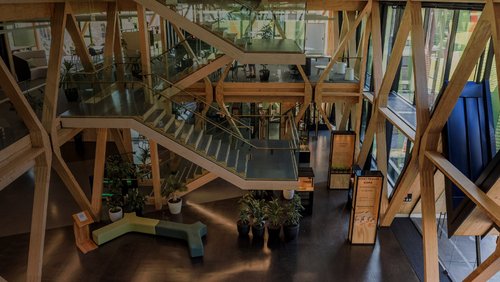22 Dec 2023
Christ Church Cathedral’s award-winning stabilisation phase is complete, marking a major milestone in the church’s reinstatement.
As an iconic structure at the heart of Ōtautahi, Christ Church Cathedral has been a vital part of the city’s identity for more than a century. Nearly 13 years after the devastating earthquakes that severely damaged the building, the cathedral is rising again, with stabilisation completed in March 2023. The foremost phase in the three-phase cathedral reinstatement project, stabilisation began in May 2020 and involved making the Christchurch building safe to enter and work in.
“I don’t know of any other projects where a building has been stabilised to this extent in order to carry out the main strengthening works,” says Cameron Belliss CMEngNZ CPEng, pre-construction engineer at Naylor Love, the consultant contractors for the project.
“The premise was taking it from a building classified as dangerous to something more on par with what a typical construction site would be in terms of safety.”
At the same time, the stabilisation project had to facilitate the second phase of strengthening and reinstating the cathedral. To accomplish that, the team had to thoroughly review and understand the building’s state, from minor or undamaged sections that can take some form of structural load, to wrecked and ruined areas that needed to be deconstructed.
“It’s important to find ways to enable deconstruction, especially elements that don’t contribute anything structurally – all they do is add mass and increase risk,” says Peter Carney, a structural engineer at Holmes who led the stabilisation project.
“You take a bit of the building away to better protect the rest that remains.”
The team was also tasked with preserving as much of the existing historical fabric of the structure as practically possible, which entailed working closely with the stonemasons as key resources. And while typical buildings refer to New Zealand Loadings Standard, specifically NZS 1170, for guidance on what loads to design a structure to withstand, such guidance does not exist for stabilising a badly damaged historic church.

Steel is lifted onto the south transept of the Cathedral during the stabilisation process. Photo: Christ Church Cathedral Reinstatement Limited
“Setting this fundamental structural design criteria was one way to protect the building’s heritage,” Peter says.
“We had to find the right balance of putting in temporary work frames that are robust enough to make it not just a safer place to be around and work in, but also add a better degree of protection to a significant building, and not making it such a high level of load that you almost have to take the building apart.”
The structure’s intricacies pushed engineering boundaries and required creative thinking. Some large reinforcing cages for the foundations had to be prefabricated and lifted into place using cranes to reduce the time spent working in hazardous areas. This also encompassed removing the existing roof at the centre of the building – where the four major arches intersect – deconstructing the damaged arches from above, and putting in a temporary roof.
“The best way to carry out the work was to lower everything in from above, as opposed to coming in from one side and building a structure from the ground up,” says Cameron, adding, “That enabled us to do the work without having anyone standing under a damaged archway that could potentially have stones fall off it from up to 20 metres.”
People talk about the Cathedral as a landmark in Christchurch because the spire would help them get their bearings around town, and we’re going to help reinstate that.

Lifting west wall frame into place. Photos: Christ Church Cathedral Reinstatement Limited. Photo: Christ Church Cathedral Reinstatement Limited
Such a complex project also required engineering ingenuity, and the team turned to innovative technology, such as sending in a remote-controlled robotic digger to excavate and clean up the rubble on the inside and outside of the building.
“It was one way to remove some of the health and safety risks because the operator was outside the building in a safe area,” Cameron says.
Crucial to the project’s success was the open, collaborative relationship between Holmes, Naylor Love and client, Christ Church Cathedral Reinstatement Limited (CCRL), plus clearly defined guidelines, which “... served as a decision-making framework for us to fall back on when we came up against these different questions that the building posed to us,” Peter says.
Completing this initial phase is a turning point for the cathedral’s reinstatement, and entering it for the first time was a proud occasion for Peter.
“To have those moments like we had inside the building is a recognition of getting one step closer to the end of the journey,” he says.
“I like working on these kinds of buildings because they have a strong civic connection. People talk about the Cathedral as a landmark in Christchurch because the spire would help them get their bearings around town and we’re going to help reinstate that.”
Stabilising the cathedral was no easy feat, and with such a lengthy timeline, progress sometimes felt slow.
“But then you step back and see how much has been achieved in the last year,” Cameron says. “Now the construction site is humming and there’s work happening everywhere.”
As an Ōtautahi local, Cameron notes that “the progress we’re making is starting to give people hope that the Square will be returned to what it used to be, and there is a lot of clever engineering work going on behind the scenes to make that happen”.
“I’d like to think that reinstating the cathedral will be the final piece of earthquake recovery for Christchurch.”
This article was first published in the December 2023 issue of EG magazine.





